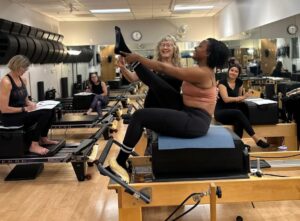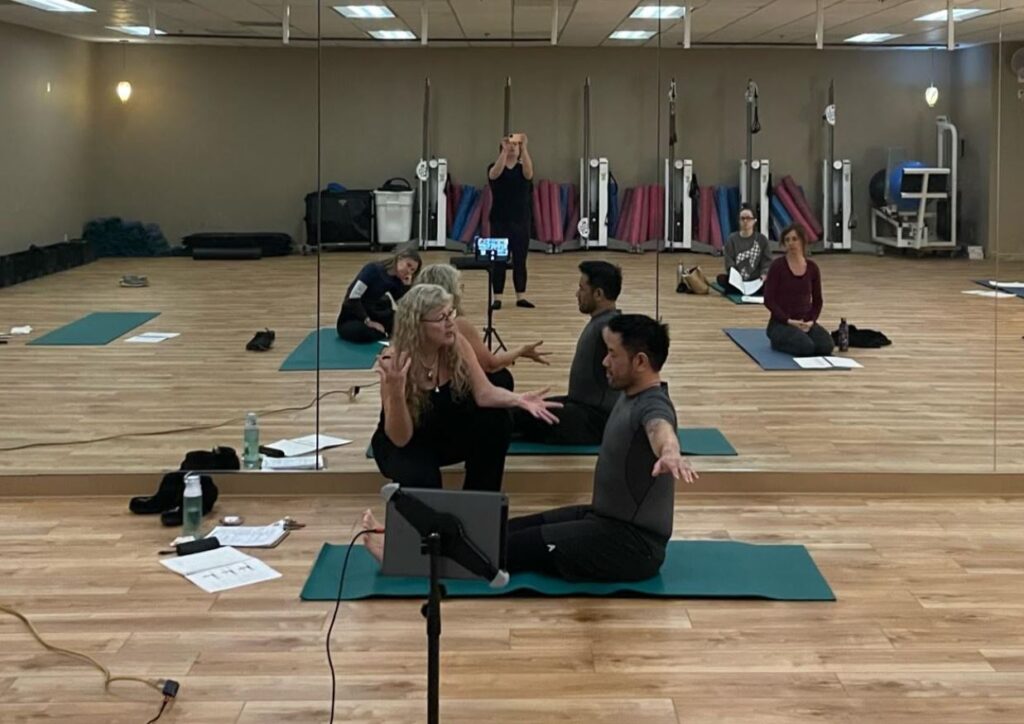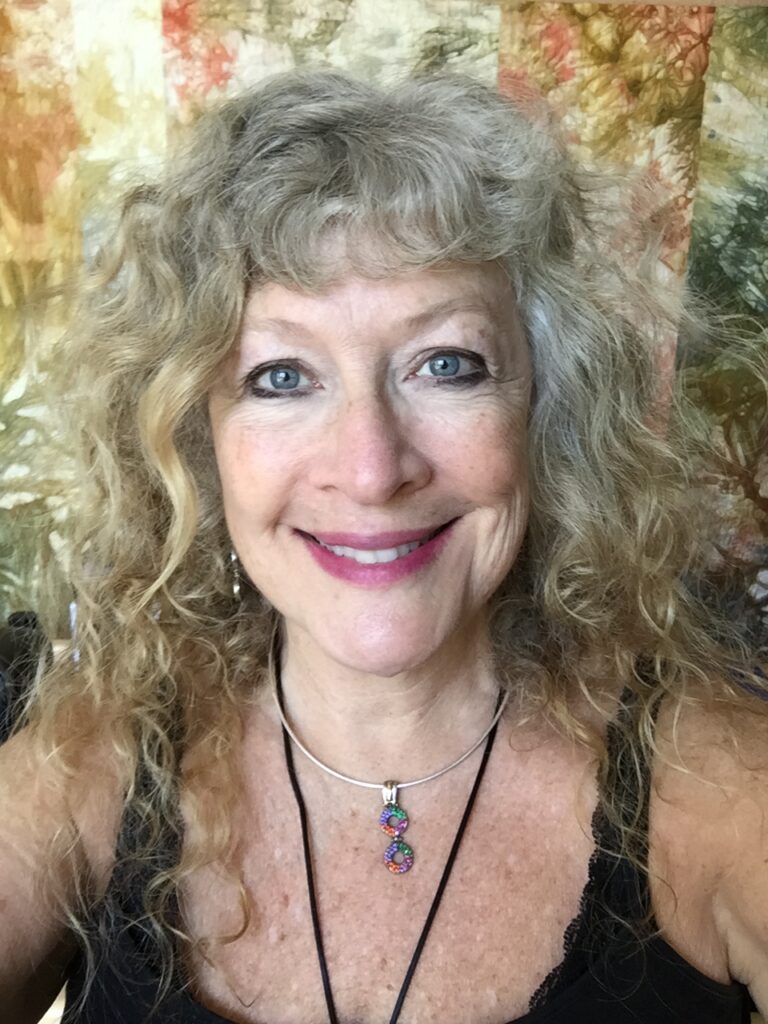Issue #409 – Wednesday, September 13, 2023
Common Myths About Working with Hypermobility
Part I
by Gwen Miller
Hypermobility is often used as a descriptive term for someone who has greater than “normal” range of motion in some or all of the joints of their body. Someone who is hypermobile does not necessarily have pain or instability. Hypermobility Syndrome and Joint Hypermobility Syndrome are diagnoses that are now referred to as Hypermobility Spectrum Disorder (HSD).
Ehlers-Danlos Syndrome is an inherited connective tissue disorder that also has a hypermobile subtype (hEDS).
The first time I worked with someone who had a hypermobile body, I was awestruck. The ranges of movement I witnessed in my client seemed magnificently beautiful and fluid … and unattainable for me. I often joke that if you ever see me do the splits, don’t hesitate, just call the medics because something is definitely wrong. My innate being had no frame of reference for the ranges of movement I witnessed.
In the “corrective exercise” and personal training world that I came from, the ranges of movement available in a person with a hypermobile body were almost things to be feared. I, like many other colleagues, fell into the trap of accepting what we were taught about working with people who had larger than “normal” ranges of movement.
Some of the beliefs I was taught, that are still in circulation, include:
- Hyperextension is bad
- Stay away from end ranges of movement
- Don’t stretch
- Keep the weights/springs/resistance light
Let’s look at these old ways of thinking with new eyes, shall we?
Hyperextension is bad
What is hyperextension? One definition is that the angle between the bones is greater than normal. What is normal? Is everyone going to have the same “normal” range of motion in their joints? Of course not. So, what is the real issue? Most joints are in their close-packed position when they are straight. This is when the articular surfaces are in maximal contact and the ligaments are taut, creating a stable unit that is ready for optimal force distribution or load bearing. To work with the human in front of us, we need to factor in more than just alignment. We also need to consider the load we are using and the activity the person is participating in. If someone is doing Footwork supine on the Reformer, their relationship to gravity is different than if they are standing. Asking a person not to lock out their knees in this situation is different than asking the person to keep their knees slightly bent in Standing Side Splits. Their close-packed position may appear to be hyperextension to us, but it actually may be their more stable position to work from. Everyone is biomechanically individual, so we need to partner with our clients who have hypermobility and discover what joint positions are best for them.
Stay away from end ranges of movement, a.k.a. “keep ’em in their mid-range” Do you notice the “othering” language in this statement? I do – and I cringe writing this. I think it’s important to face our myths and the way we speak to and about people head-on. I feel like people with hypermobility are yet another population that has been “othered” by the greater fitness industry. How many populations have been told what the best thing to do is, without being asked what they need? So many.
Staying in a mid-range may be a good way to teach someone stability and control, at first, yet I have seen too many people who use this as a forever-thing. Let’s consider this: If a person with hypermobile joints owns that greater range of movement, are we doing them a service or a disservice by not strengthening their joints in that greater range? What happens when they have been told to stay in a mid-range and trained in a mid-range, yet they travel into their greater range in real life?
Don’t stretch
People with hypermobility may experience tightness or muscle spasms in large muscle-tendon groups. In these cases, stretching is recommended to relieve pressure on joints that may contribute to pain.
However, static stretching, in which a stretch is held without moving, at end range, may lead to further instability. Therefore, active, or dynamic, stretching is a better choice for a hypermobile body. Active stretching is a technique wherein the person moves into and out of a stretch in a smooth and controlled rhythm, eliciting a gliding of the tissues. This warms up the area being stretched, and promotes circulation and lubrication of the tissues, potentially relieving pain and neurological responses to pain such as anxiety and stress.
Another question to ask is WHY is the muscle tight? Muscle tightness, or muscle spasms, may be a neural stabilization strategy, in which case the person needs to combine neurodynamic stretching with global stabilization and strengthening.
Keep the weights/springs/resistance light
Really? How much does a gallon of milk weigh? How about a 2-year-old child? A laundry basket? A bag of groceries? You get my point. Certainly, starting light may be a good idea, depending on the fitness level and training age of the human in front of you. The weight also depends on the person’s relationship to gravity and the stabilization strategy in their joints. Each person’s starting point will be different, and careful progressive loading is key.
Consider the difference in stabilization needed for open-chain versus closed-chain activities or exercises. Open-chain, as you recall, is when the body is not in contact with a solid surface, such as Pulling Straps or Feet in Straps. Closed chain would be standing work for the lower extremity and plank-type work for the upper extremity. An additional consideration is whether the weight is being used to create resistance or assistance in an exercise.
I’ll never forget a lightbulb moment learning Knee Stretch, when I realized that the intention of the heavy springs was to assist the stability of my shoulders. My body immediately understood how the Reformer and I were now one, and the heavy weight was actually helping me. That same weight in an open-chain environment would create more challenge than assistance, in my opinion (albeit the feedback from the springs to connect the whole body – is a whole ‘nother topic, and a good one!).
So, considerations for training include the relationship to gravity, the intention of the weight, and the kinetic chain.
In Part 2, I’ll outline some strategies we can use to maximize the effectiveness of our work with someone who has EDS or HSD.
To learn more about HSD and EDS, visit my blog at https://www.gwenmillerstudio.com/news/
Ehlers-Danlos Society
https://www.ehlers-danlos.com and/or https://www.ehlers-danlos.org
Gwen is the author of Safe Movement for All Spines – A Guide to Spinal Anatomy and How to Work with 21 Spine and Hip Conditions, published by North Atlantic Books and distributed by Penguin, available from multiple booksellers.
As a Principal Educator for Balanced Body® Pilates Education, she enjoys mentoring teachers and developing community amongst movement professionals.
Gwen’s Pilates journey began after she was diagnosed with degenerative disc disease and degenerative joint disease. She had the amazingly good fortune to have contemporary Pilates legend Elizabeth Larkam as her primary teacher and mentor during her time at Balanced Body University.
She remembers, “during my training, it was me and two PTs in the Balanced Body modules at the San Francisco Bay Club. They were on a fast track, and I had not planned to be, but the moment I realized the opportunity I had, to learn how to teach Pilates from Elizabeth, I jumped on the train and never looked back. It was one of the best decisions I have ever made. Elizabeth was very much into post-rehabilitation, and her influence has stayed with me through the years. She was so gracious, when I had passed my Comprehensive exams and started teaching, she mentored me, talking me through how to teach a class, how to walk through and cue, and what to do to best be prepared and not to be nervous. I find great joy in providing the same excellent care and help to my students, honoring the mentoring she provided me by passing it along.”
As a Hendrickson Method® Manual Therapist Gwen combines orthopedic manual therapy with movement to help her clientele achieve and maintain their quality of life. She has coined the term “Integrated Therapy” to describe her blend of modalities.
Her advanced certifications qualify her to work with spinal pathologies, with an emphasis in working with scoliosis. She is a Corrective Holistic Exercise Kinesiologist (CHEK Practitioner 3), Master Scolio-Pilates® Teacher, and is Yoga for Scoliosis® Trainer certified.
Gwen’s current project, The Dynamic Spine: Safe Movement for All Spines (and Hips), is a continuing education curriculum and mentorship based on her book that synthesizes over two decades’ training and experience in working with special populations to educate and empower the next generation of teachers.




